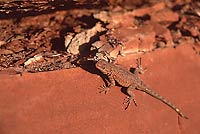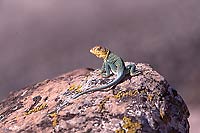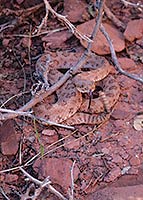The heat of spring brings out the ectotherms – literally. The term “ectotherm” is from the Greek words meaning “outside heat” and refers to animals which rely on environmental heat sources (i.e. warm temperatures) to become active. Many of these creatures, such as frogs, lizards, snakes and insects, may spend the winter in a sort of suspended animation, called torpor, where their metabolic rates are reduced to minimize energy needs. 
Out of all these creatures, the most notable ones are the lizards and snakes that inhabit Canyon Country. Overwintering in cracks and crevices, beneath boulders or in dens, these reptiles make up a noticeable and interesting segment of the region’s wildlife.
Due to their small stature, side-blotched lizards may appear outside in winter on warm, sunny days. Their small body mass can heat up quicker than a larger lizard, hence they may take advantage of warm spells to forage. Noted for the dark patch behind their front leg, these small lizards may fall prey to larger lizards, snakes or birds.
Besides the side-blotched lizard, ornate tree lizards and plateau lizards may also be considered “small” lizards in the area. Ornate tree lizards have a pattern of black chevrons down their backs and they may be observed climbing along rock faces or on trees. Male plateau lizards, often viewed perching on a post, boulder or other high point, sport blue coloration under their throats and bellies. This coloration may be faint or lacking on females.
A little larger, the desert spiny lizard has overlapping, pointed scales on their bodies and a dark patch on their throat. Like most lizards, these creatures may be observed sunning themselves as they survey their territories for prey, predators, and competition.
 The two largest lizards in the Moab area are the long-nosed leopard lizard and the eastern collared lizard. Like it’s namesake, the leopard lizard is covered with dark spots. Both sexes may change coloration during the season; females develop reddish-orange spots on their sides when they are “gravid” which means when they are carrying eggs. The eastern collard lizard has brilliant yellow and turquoise coloration and dark neck bands. These stunning lizards may also rear up and run on their hind legs. This bipedal motion is used to escape or chase prey.
The two largest lizards in the Moab area are the long-nosed leopard lizard and the eastern collared lizard. Like it’s namesake, the leopard lizard is covered with dark spots. Both sexes may change coloration during the season; females develop reddish-orange spots on their sides when they are “gravid” which means when they are carrying eggs. The eastern collard lizard has brilliant yellow and turquoise coloration and dark neck bands. These stunning lizards may also rear up and run on their hind legs. This bipedal motion is used to escape or chase prey.
Though lizards inspire a sense of curiosity, their reptilian relatives – the snakes – seem to ignite a sense of fear in many visitors. Of course, the midget-faded rattlesnake’s “buzz” is enough to get one’s heart racing, but this snake posses’ little threat unless provoked. The vibrating buttons on the tail tip sends out a warning signal that halts most predators or unsuspecting hikers. Even if the snake strikes, it may not envenomate. 
Other common desert snakes include gopher snakes, garter snakes, and striped whipsnakes. Of these three, the gopher or bull snake may mimic a rattlesnake by coiling up, flattening its head, and vibrating its tail. Non-poisonous, these snakes rely on the rattlesnake’s reputation to cause predators to pause long enough that the snake can slitter away.
These desert reptiles are cool to observe and appreciate, but please remember to leave them be. It is considered harassment trying to capture one and some lizards may lose a tail trying to escape. Observe and enjoy and appreciate the spring warmth just like an ectotherm.



 The two largest lizards in the Moab area are the long-nosed leopard lizard and the eastern collared lizard. Like it’s namesake, the leopard lizard is covered with dark spots. Both sexes may change coloration during the season; females develop reddish-orange spots on their sides when they are “gravid” which means when they are carrying eggs. The eastern collard lizard has brilliant yellow and turquoise coloration and dark neck bands. These stunning lizards may also rear up and run on their hind legs. This bipedal motion is used to escape or chase prey.
The two largest lizards in the Moab area are the long-nosed leopard lizard and the eastern collared lizard. Like it’s namesake, the leopard lizard is covered with dark spots. Both sexes may change coloration during the season; females develop reddish-orange spots on their sides when they are “gravid” which means when they are carrying eggs. The eastern collard lizard has brilliant yellow and turquoise coloration and dark neck bands. These stunning lizards may also rear up and run on their hind legs. This bipedal motion is used to escape or chase prey.